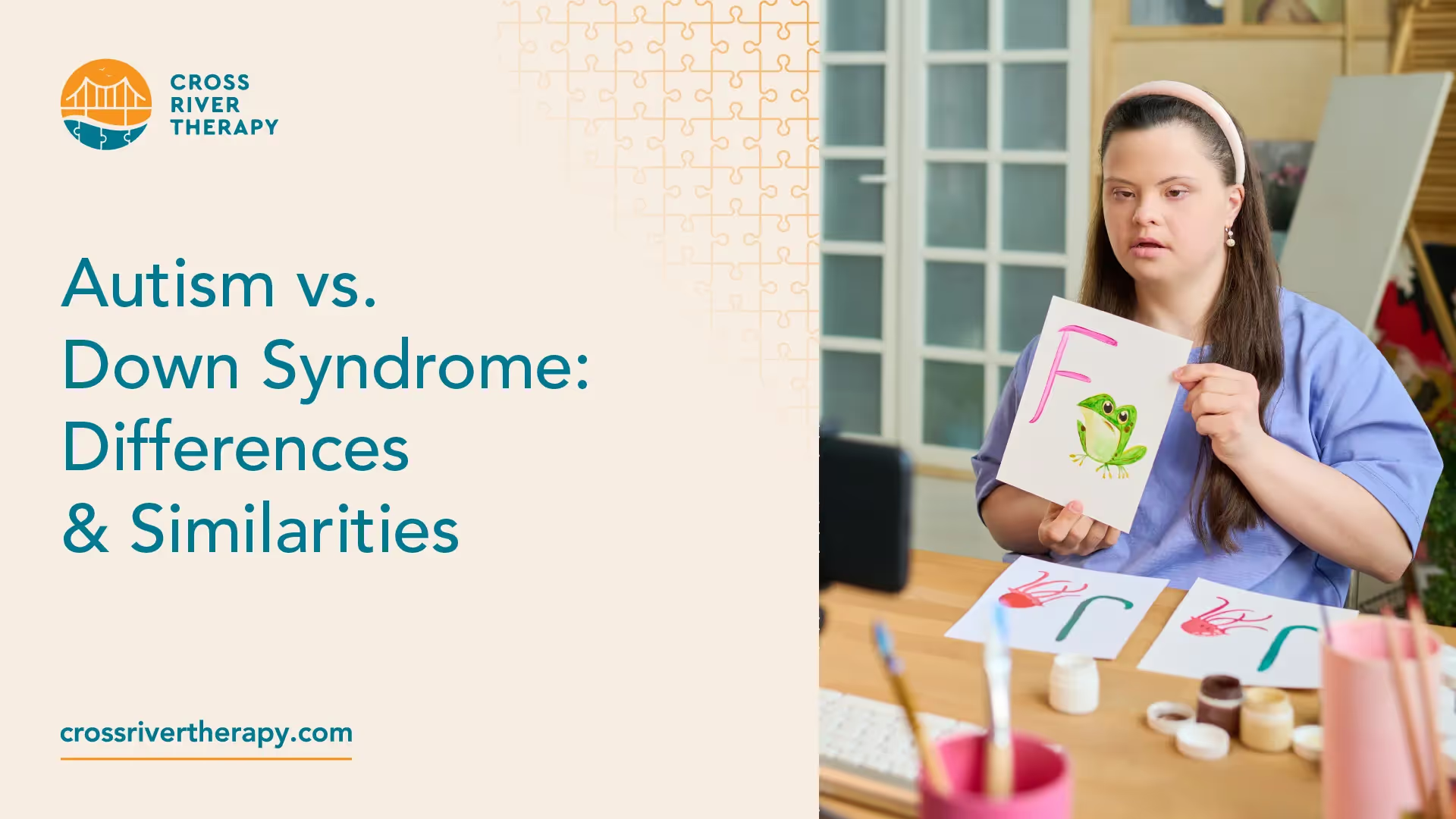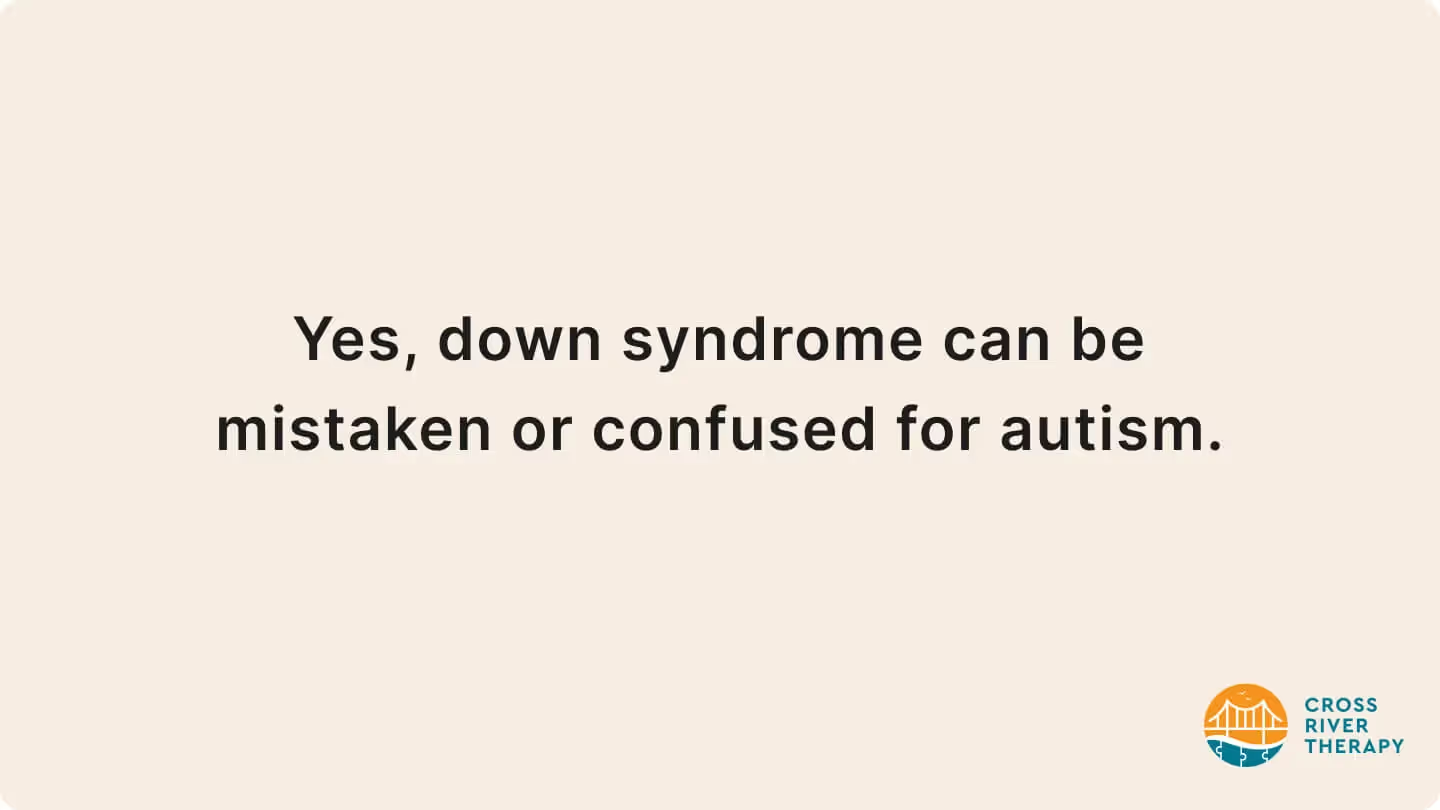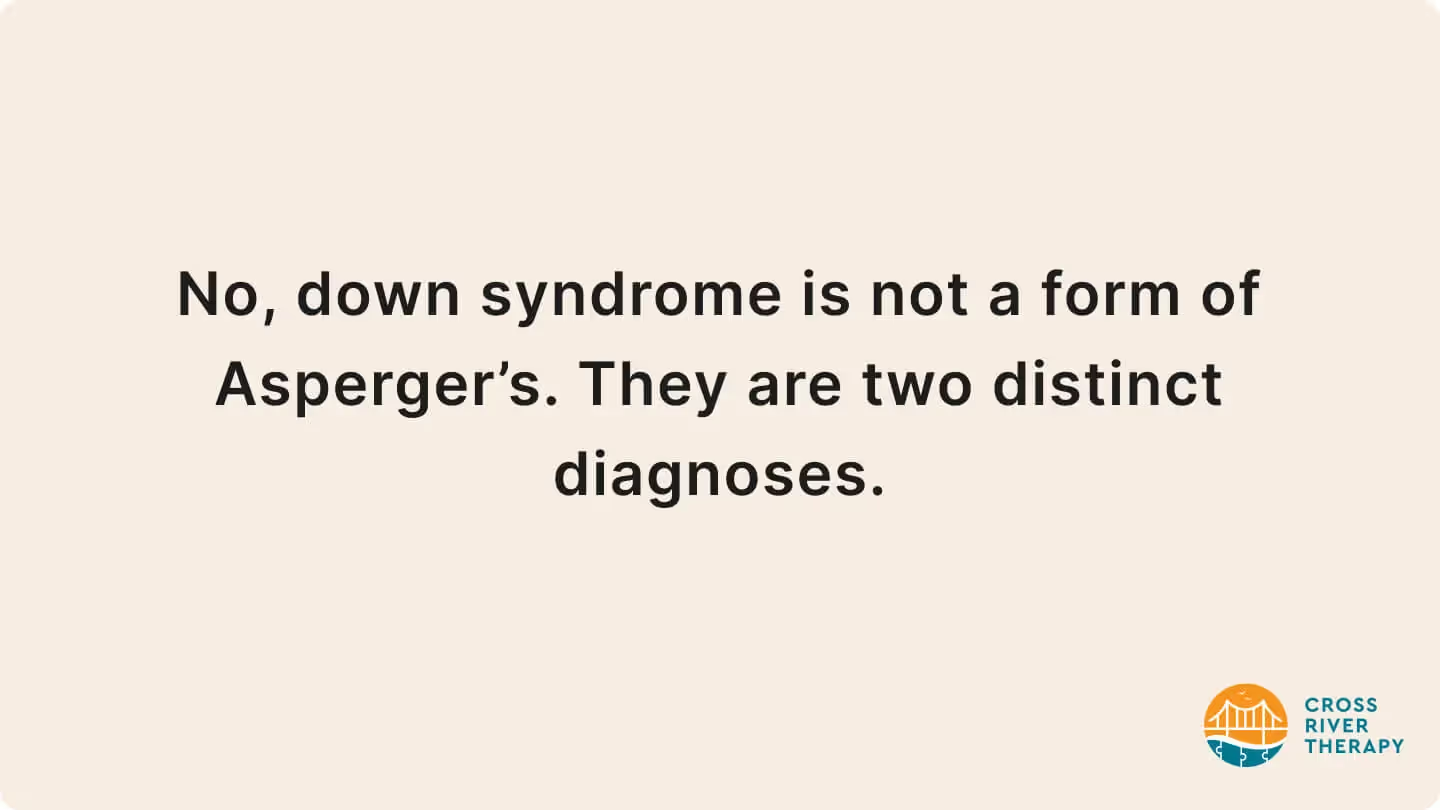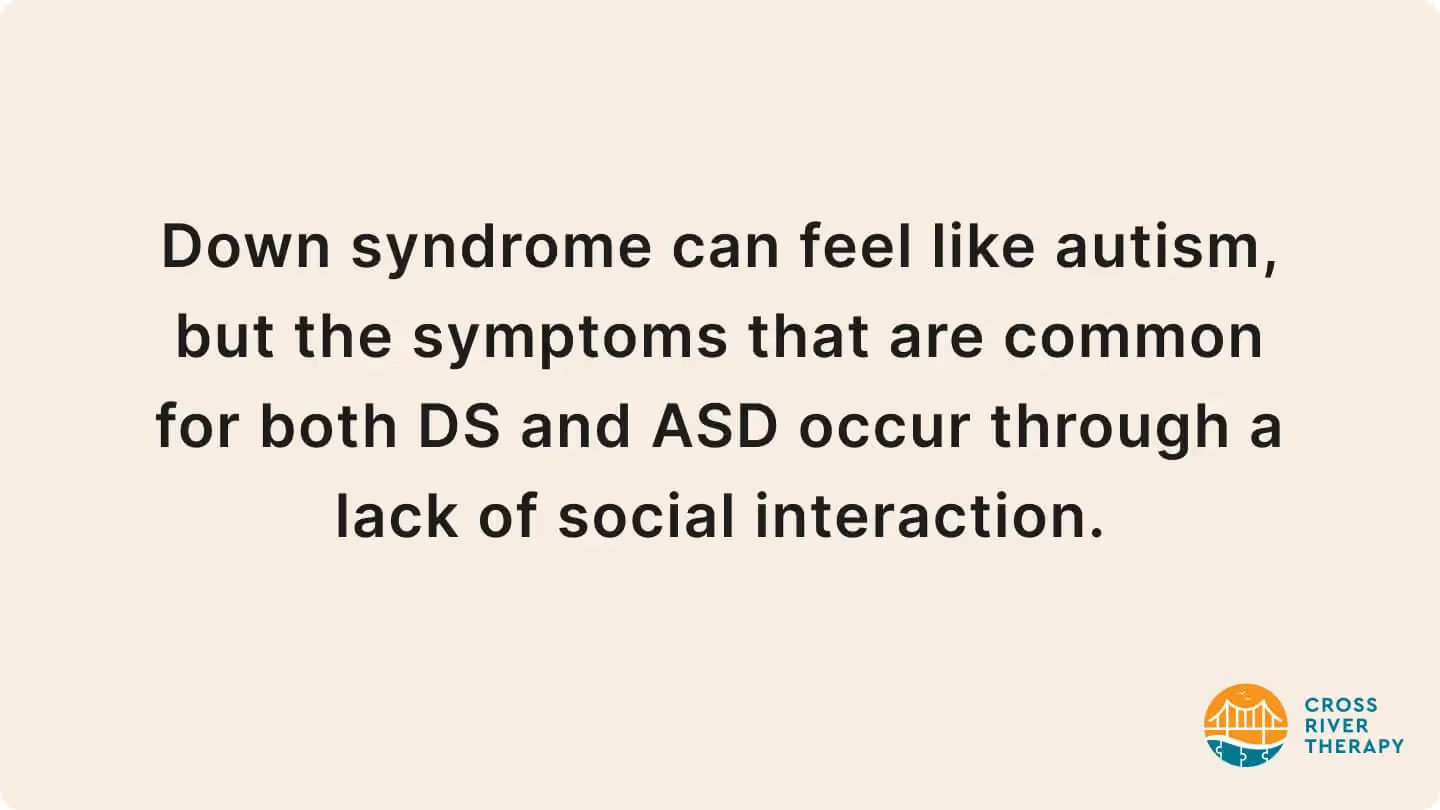Autism vs. Down Syndrome: Differences & Similarities
Autism and down syndrome have similarities and differences. We’ll show you what they are in this guide.
Key Differences
Down Syndrome
Down syndrome, also called trisomy 21, is a disorder stemming from chromosomes. There will exist another chromosome copy of 21, either completely or partially.
Down syndrome isn't a hereditary disorder, though material aging can determine who is at higher risk of having a child born with it. Essentially, people that have children in old age stand the most chance of giving birth to an infant with the disorder.

There's prenatal screening just for this purpose, allowing a diagnosis of Down syndrome to be seen while the baby is still in the uterus.
A doctor can make a diagnosis immediately after birth when this occurs, though some observation is possible. A Down syndrome diagnosis is very basic compared to the way it's done for autistic people. Most of it deals with direct observation and analysis of the chromosomes.
How extreme one's Down syndrome is can vary. Learning disorders may branch off from it and harbor delays in development, learning problems, and intellectual disabilities. Some even have numerous heart defects that lower their life expectancy.
Most people with Down syndrome have distinctive features on the face that make it easy to identify. Below are the following:
- Short neck - The neck might be visible but very short in length.
- Upward slanting eyelids - This is a common characteristic of Down syndrome. The eyes will protrude at a slight angle in an upward direction toward the forehead.
- Small head - The head's shape might be rounded and its size smaller than people without the disorder.
- Flat face - The face will appear flattened from the forehead to the chin.
- Poor muscle tone - Although people with Down syndrome are sometimes capable of gaining muscle mass, many have poor form, arms, and limbs that don't appear to match the size of their torso.
- Short hands - The hands are smaller than what they would appear to be, especially when compared to the rest of the body. In the palms, only a single crease will show.
- Small fingers and toes - The feet are smaller than what they would appear to be compared to the entire body.
- Brushfield's spots - These are small white spots along the colored portion of the eyes. They're common in people with Down syndrome but also those without it, particularly in people with blue eyes.
- Varied facial features - This tends to not be the same for every person with the disorder. Most babies that are diagnosed will grow slowly and be shorter than their peers.
Many DS kids will have moderate to poor cognitive abilities. They might experience delays in language and speech, including issues remembering things that occur around them.
Many toddlers with DS undergo therapy to help them out with their language abilities and speech. To do this requires consistent interaction with a pediatrician. Studies prove that DS individuals can have numerous unexpected health issues later in their life.
Autism
A developmental condition, Autism Spectrum Disorder is a complicated set of conditions characterized by problems with social communication, behaviors that are repetitive, and a lack of interest in things that most would be intriguing.
The condition lasts for a lifetime and has a wide range of symptoms and indicators that can differ for every person with the disorder.
An autism diagnosis is done by a psychiatrist or equivalent. The signs could become noted when children are at toddler age. In some instances, the symptoms might not be noticed until a child begins school and limits their social interaction with others.
It's common for teachers and faculty that contact parents with concerns about their child possibly having undiagnosed autism.
Social issues commonly found in autism are many. Here are those most commonly noticed by psychiatrists:
- No interest in socializing - There would be no interest shown in sharing things with others, like toys.
- Eye contact is hard to do - Poor eye contact can make communication with an autistic person awkward and even impossible. They might be able to talk but continue avoiding eye contact with everyone around when it's socially expected for people to do so.
- Not able to make friends - Friendship becomes too big of a challenge for many to carry out, making it common for those with ASD to find people their age to play with, talk to, and be around outside of a school environment. This can lead to depression and shyness.
- Unusual speech patterns - The cadence of someone with autism might appear odd, like an automated voice on a voicemail box. This too can make friendships hard since other children around might feel awkward, especially when they're unaware of what autism is.
- Repetitive behaviors that seem to get worse - Repetitive behaviors are likely to get worse when no effort is made to correct them before they're too adapted. At its most extreme, repetition can prevent autistic children from going to school and learning with their peers.
- Coping issues - Problems in coping with the world around them and the constant changes that take place.
- Unusual topic interests - Things their peers might not be interested in might be fascinating to someone with autism. This isn't necessarily a negative trait but can make it difficult for them to bond.
- Hypersensitivity - Things like loud noises, beeps, screeches, bright lights, and sudden changes in room temperature cause them discomfort and anxiety.
- Reactionary to change - Cannot accept change or any alterations to their routine.
- Stimming - Repeating movements and gestures at an unusual rate. Can cause extreme symptoms to show.
- Unusual organization - Organizing toys in a way that appears to interest them more than the toys themselves.
When autism is diagnosed early, it helps the child learn methods of handling their symptoms.
Autism doesn't go away but interventions that occur early on in life can help them improve their social interactions and skills in communication. It's not a condition and there isn't a single cure for it.
Key Similarities
Down Syndrome
- Routine - Like autistic people, those with DS prefer to do things based on what they know or a routine they're familiar with.
- Doesn't always respond to their name - This is also a common trait found with autism, especially in young children and infants.
- Eye contact is difficult - Eye contact might not be a problem for some with DS, as some can be very outgoing and personable. But it's not uncommon to see some with the condition that doesn't.
- Sensory differences - They may respond negatively to loud noises and lights, no different than symptoms presented with autism.
- Repetition in play - Like playing with objects and in ways that are constantly repeated.
- Behaviors that are challenging - Although the severity of both DS and ASD can vary greatly, both can exhibit behavioral patterns that are sometimes alike, such as making noises, waving arms, hands, and excessively repetition.
- Interests that are intensely focused - Take a big interest and focus on single objects, sometimes items that might appear mundane.
- Anxiety - Anxiety is shared among the general population and people with Down syndrome and ASD are prone to getting it too, more so under specific conditions.
- Differences in development - In comparison to the public, DS and ASD both harbor major differences with people that don't have either.
Autism
- Problems with the digestive system - Autism's connection to gut health has been increasingly studied, with new information coming out occasionally. Individuals with Down syndrome also have problems with the digestive tract, like constipation.
- Seizures - Seizures are more likely to occur in ASD and DS people. Additionally, epilepsy is sometimes an overlapping condition found in both.
- Difficulty sleeping - Because Down syndrome and autism sometimes maintain symptoms that can cause anxiety, racing thought may inhibit good sleep.
Symptoms
Both autism and Down syndrome share persistent symptoms. Both might be withdrawn or feel indifferent towards others, especially people outside of who they live.
Autistic individuals may learn and take on language differently than the general public, and so is the case for those with Down syndrome.
Down Syndrome
- Using signs, gestures, and symbols for communication - Although plenty of Down syndrome individuals can engage in conversation, some with extreme conditions may communicate through hand gestures or other means.
- Copies other people - This is most common in people with Down syndrome when they're around someone they admire, like a good friend or loved one. At times, they can pick up much knowledge this way.
Autism
- Few to no gestures - This can vary on the person diagnosed. In some people that have autism, gestures are more common than not.
- Atypical demeanor - May treat others as if they're not sentient or come across as rude. May make socially inappropriate comments when speaking.
Causes
Down Syndrome
- Conceiving children at an old age - Couples that conceive when they're not young anymore run a higher chance of having children with the disorder. This also raises the chance of giving birth to an autistic child.
- Poor to moderate cognition - Some with Down syndrome can do most tasks that the general public is capable of, but cognition is likely to be poor.
Autism
Numerous factors can cause autism. Here are those most commonly found:
- Genetics - Gene mutations and families with a history of autism have a high chance of having an autistic child themselves. Being exposed to pesticides and drug use during pregnancy also increases the risk, as can inflammation in the uterus.
- Biologication conditions - Inflammation and specific infection during pregnancy can increase the chances of ASD being diagnosed later on.
Diagnosis
Down Syndrome
When Down syndrome is diagnosed, it's classified under three separate conditions:
- Trisomy 21 - This occurs when all cells ostensibly have a third copy of chromosome 21.
- Mosaic Down syndrome - Occurs when there exist three copies of chromosome 21 and when some contain just two copies present.
- Translocation Down syndrome - Occurs when there's an additional copy of chromosome 21 that's attached to another chromosome.
To detect Down syndrome, a doctor will check the child's physical characteristics while still in the womb. Further analysis can quickly find, where one of the three classifications is presented during the diagnosis.
Autism
An autism diagnosis typically happens after a child is born, during the period after six months of age. A pediatrician may notice signs such as a child not responding to their name, poor motor abilities, and a lack of interest in certain toys.
More studies are conducted as they reach toddler age, where a classification between three levels is best made. The three levels of autism can determine its severity and offer assistance in a therapist's treatment plans.
Treatment
Down Syndrome
Support for people with Down syndrome is sometimes identical to what's given to people with autism. Therapy sessions tailored to help with their language abilities and cognitive deficiencies are offered nationwide.
Autism
Autism's treatment, particularly at childhood age, is Applied Behavior Analysis, followed up by more therapy as it's needed into their adolescence and beyond.
Co-Occurring Autism And Down Syndrome
Down syndrome and autism can occur at the same time. Regardless, autism is usually found through behavioral changes and might not be noticed as easily as Down syndrome.
FAQs
Can Down Syndrome Be Mistaken For Autism?
Yes, but this is more common when testing for Down syndrome isn't done during the prenatal period.

Is Down Syndrome A Form Of Aspergers?
Asperger's is a feature that's common among autistic individuals, but uncommon in people with Down syndrome.

Can Down Syndrome Feel Like Autism?
Yes, but the symptoms that are common for both DS and ASD occur through a lack of social interaction.




